How to care for Kalanchoe at home
Kalanchoe is the best-selling plant in the whole world and in Russia. You can’t tell for some species, but this is a succulent, which means a very unpretentious and fashionable green friend. What you need for novice florists!
If there is not a single Kalanchoe in your home flower garden yet, this can be easily corrected. We offer some tips and tricks on how to choose a flower, how to transplant it, and how to properly care for the plant in order to protect it from seasonal diseases. Also at the end of the article you will find a selection of Kalanchoe photos in the interior.
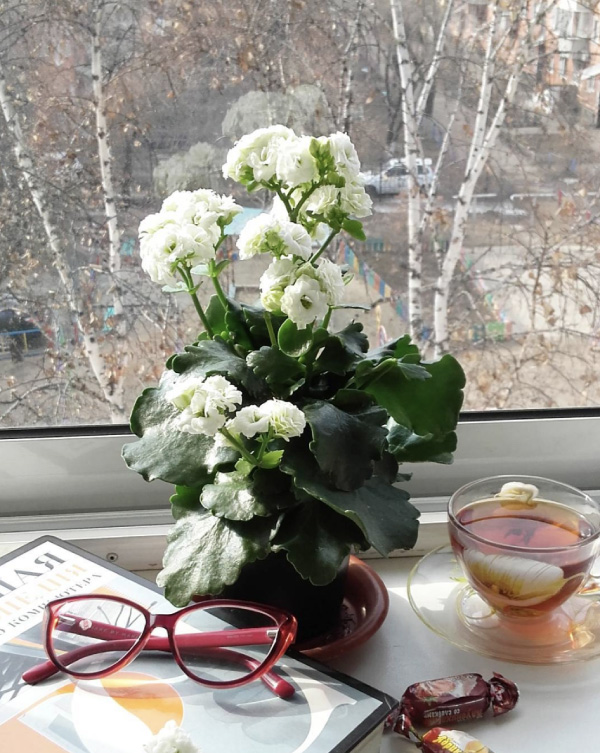
Follow just a few simple rules, and the indoor Kalanchoe will delight you with its rapid growth and bright colors.!
Types of Kalanchoe with a photo
Kalanchoe has more than two hundred species, but the following varieties are most common as an ornamental indoor plant in Russia:
- Kalanchoe Kalandiva (Kalanchoe blossfeldiana ‘Calandiva’) is the brightest and most luxuriant variety with multi-petalled flowers, similar to small roses of different colors – they are white, red, pink, yellow. The plant itself is small, but blooms very violently..
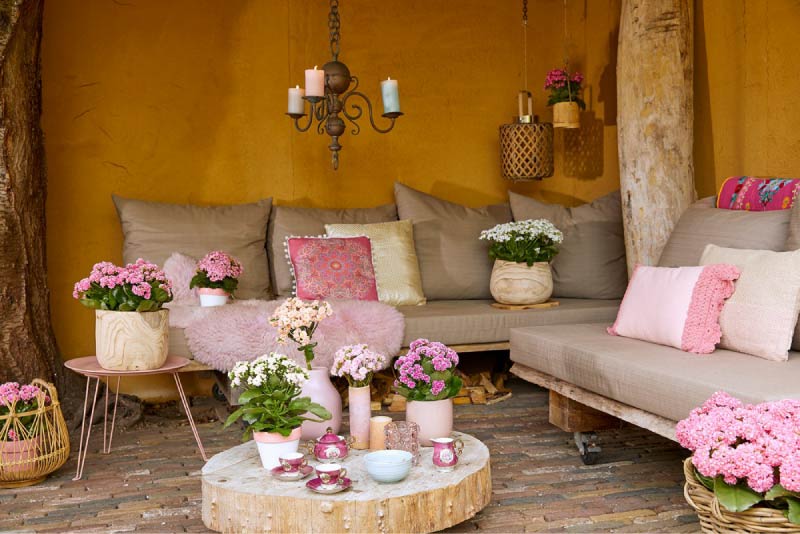
Kalanchoe Kalandiva in the interior
- Kalanchoe Blossfeldiana (Kalanchoe blossfeldiana) – a variety similar to Kalandiva, but more modest in size – the bushes reach a height of about 30 cm, have rounded ribbed leaves and small flowers.
- Kalanchoe pinnata (Kalanchoe pinnata), like Kalanchoe Boveri, will suit lovers of those very “strange succulents”. This animal grows up to 80 cm at home, has an erect stem and dense elongated leaves that resemble the open mouths of small crocodiles due to their wavy edge. The flowers look like dim bells, and the fruit is a box with small seeds..
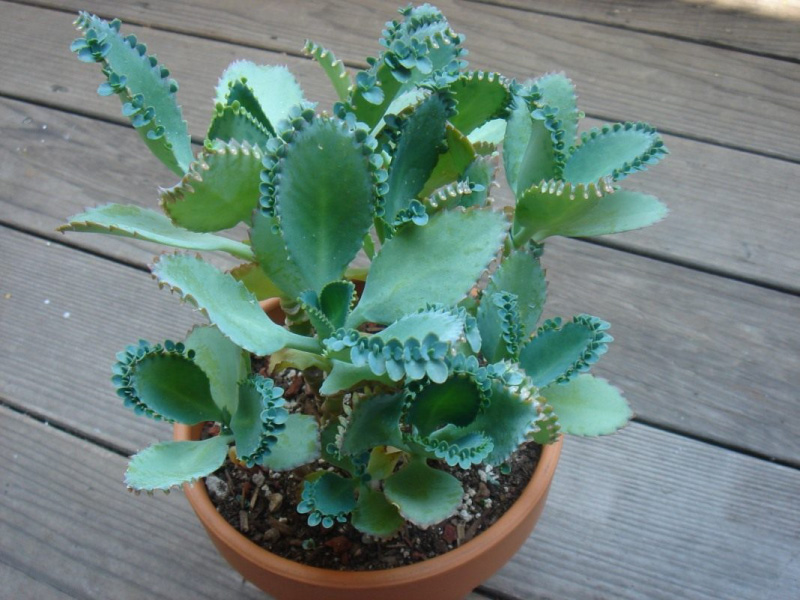
- Kalanchoe beauverdii looks like a green stick insect is sitting in a flower pot – its narrow tubular leaves up to 5 cm long curl into rings with age and acquire a pinkish tint, and the flower itself can grow up to 100 cm in height. His flowers are ringed, light purple.
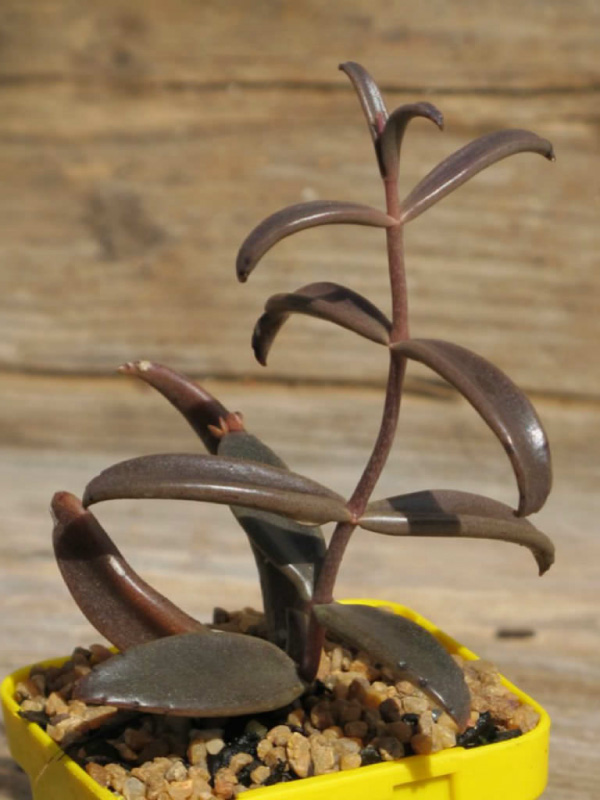
- Kalanchoe manginii (Kalanchoe manginii) is a short, but bulky plant with glossy round leaves. Blooms gorgeous, covered with many bright drooping bells.
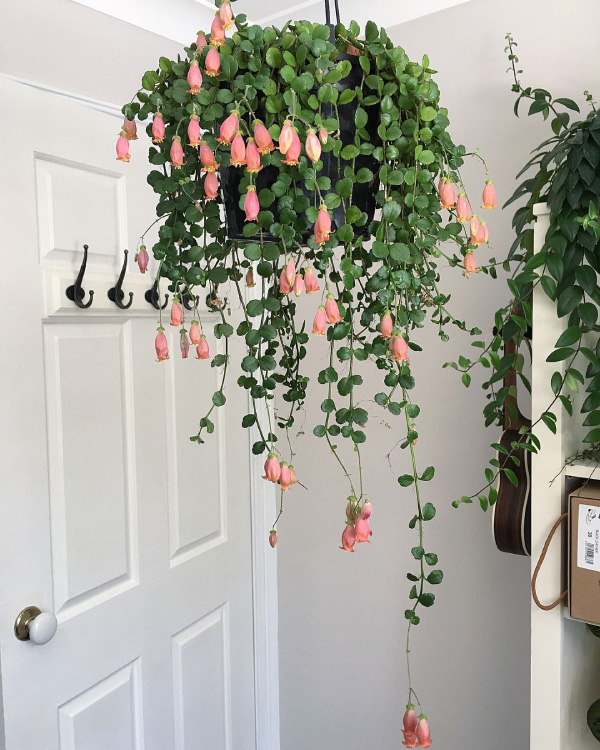
- Kalanchoe tomentosa (Kalanchoe tomentosa) is a mysterious shrub with silvery-green, as if fluffy, leaves, the edge of which seems to be burnt – it seems so because of the brown border. His flowers are the same fluffy, with a dark stripe in the center of the petal. Perhaps this is the most “alien” Kalanchoe variety.
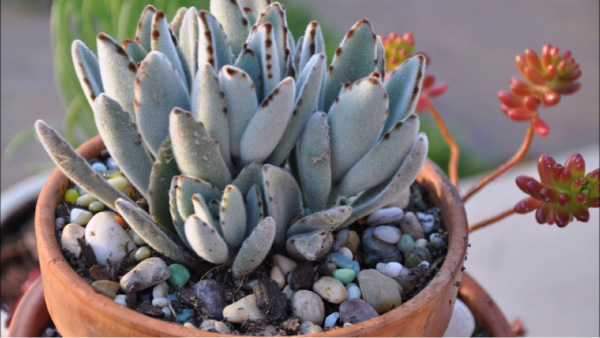
Conditions of detention
Like all succulents, Kalanchoe grows well at home at normal room temperature. Almost any place in the house that meets the standard requirements is suitable for him – not in the shade, not in a draft, not in heat or cold. From May, you can take out the plant to breathe in the garden, terrace or on the balcony, if it is not very frosty and not too hot outside. Minimum temperature – + 8 ° C, optimal in summer – + 20-24 ° C, too hot air can lead to the fact that the plant does not form flower buds.
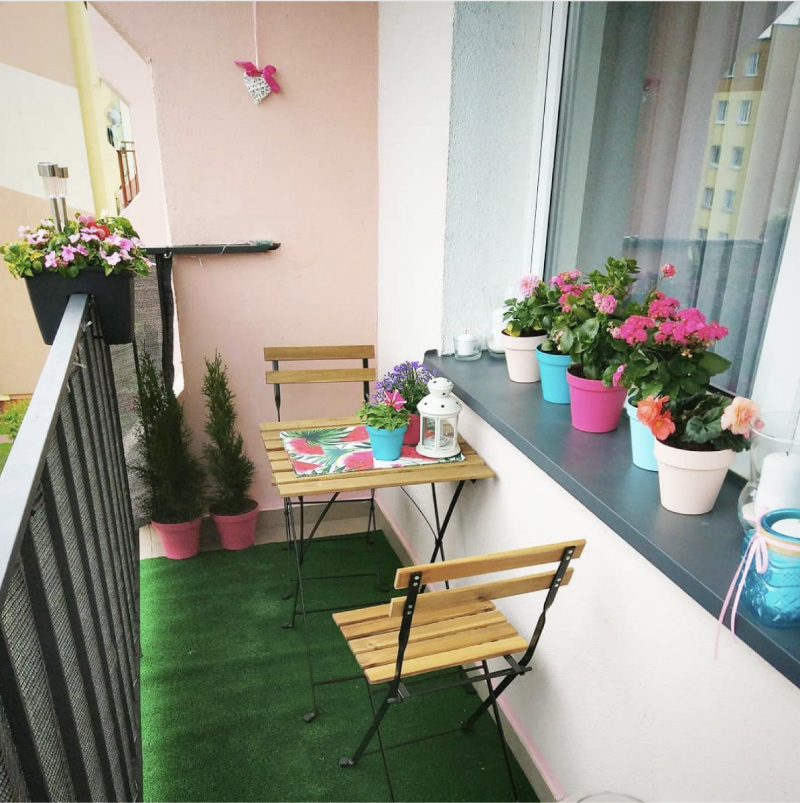
Kalanchoe Kalandiva on the balcony
As for lighting, Kalanchoe is happy with the brightest sun and is not afraid of direct rays. On the contrary, the morning and evening sunlight will only cheer him up. The plant pot can be kept on a window facing east or west. If the window faces south, it is still better to cover the flower from the scorching midday sun. True, the felt Kalanchoe, due to its endurance, can grow in direct southern rays. The only thing to remember is that immediately after buying and moving the plant is stressed, so in the first days it is better to shade it with gauze or tulle, and after about a week you can open access to direct sunlight.
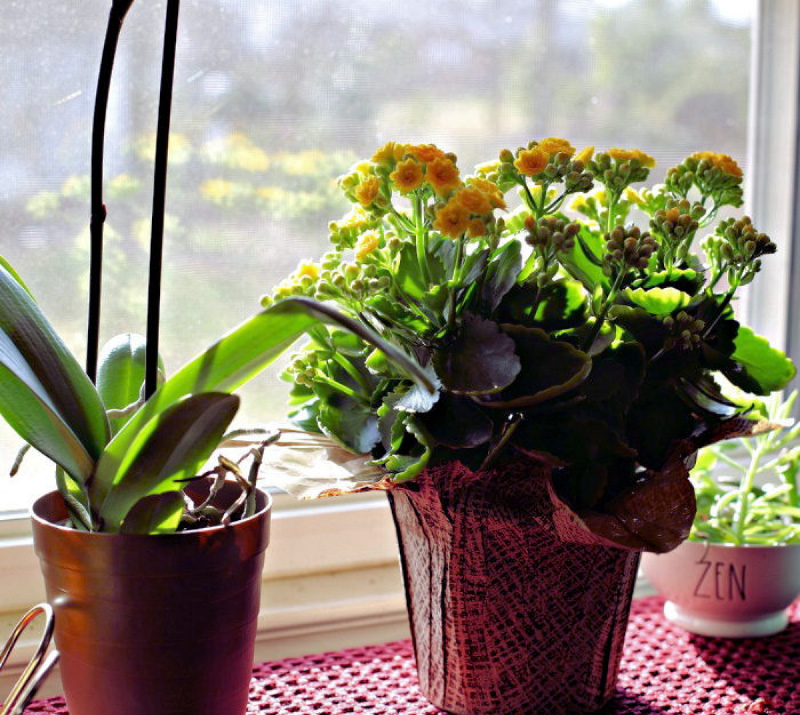
- In winter, during the dormant period, the Kalanchoe responds well to a temperature of 10-12 ° C and a dry regime (watering once a month). With a daily temperature difference of 5-7 ° C, the process of bud formation and flowering is accelerated.
See also:
- Caring for zamiokulkas (dollar tree) at home
- How to care for aloe at home
- A tree in a room: how to care for Benjamin’s ficus at home
- How to care for dracaena at home
- Anthurium – home care guide
- How to care for begonia at home
- Home care for indoor hydrangea
- How to care for a shefflera at home
- How to care for geraniums at home – a beginner’s guide
- How to care for myrtle at home
- How to care for orchids – 7 steps for a beginner
- How to care for a money tree (bastard) at home
- How to care for violets at home
- How to care for hibiscus (indoor Chinese rose) at home
How to water Kalanchoe
With watering Kalanchoe, there is a firm rule – “It is better to underfill than to pour!” It’s okay if you dry out the soil a little. But its waterlogging can lead to rotting of the roots and death of the flower. Use soft warm, well-settled water for irrigation – in a word, one that all flowers respect.
- Kalanchoe is watered moderately during the period of growth and flowering – in spring and summer 1-2 times a week. In autumn, less often, in winter, and at all once every two weeks.
It is important not to forget about drying the top layer of the soil. In summer, the land should have time to dry out to the upper third of the pot between waterings, in winter – by 2/3. This is difficult to verify, so just wait a few extra days with watering after the soil dries out from above. If the air temperature is above 22 ° C – a day or two, if 18-22 ° C – 3-4 days, if below 18 ° C – it costs about a week to wait with watering.
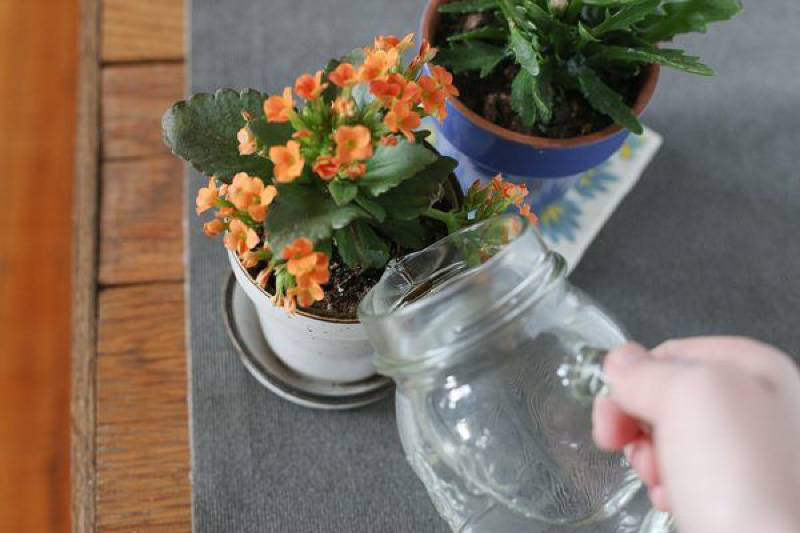
The Kalanchoe does not like too dry air, therefore, periodic spraying of the leaves from a spray bottle will not hurt. You should not spray water on the buds and flowers, but the leaves will be happy with a little soul, because this is not only a way to wash off the dust, but also prevention against a tick.
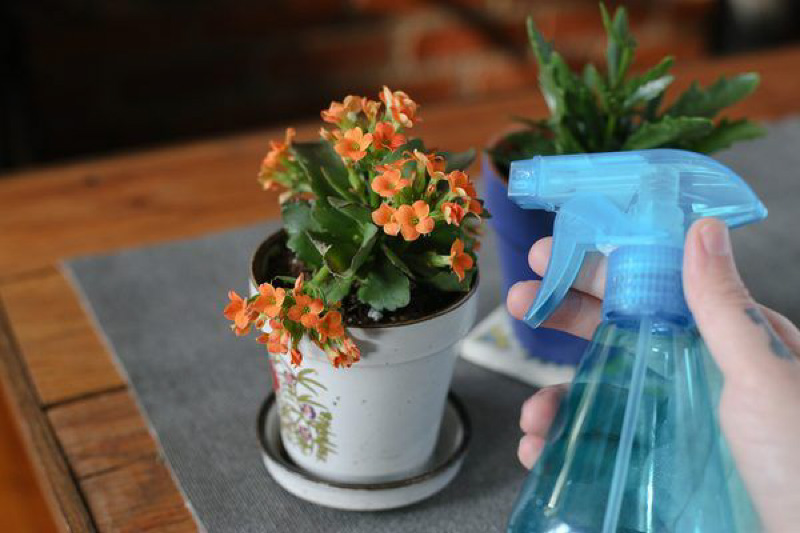
Top dressing Kalanchoe
Kalanchoe is unpretentious and can do without feeding, but, of course, moderate feeding has not harmed anyone yet.
- It is best to feed the plant from late spring to mid-summer. Infrequently – once a month. For this, special formulations for succulents are suitable. For example, POKON, AVA and others. If you have a non-flowering variety, any cactus fertilizer will do..
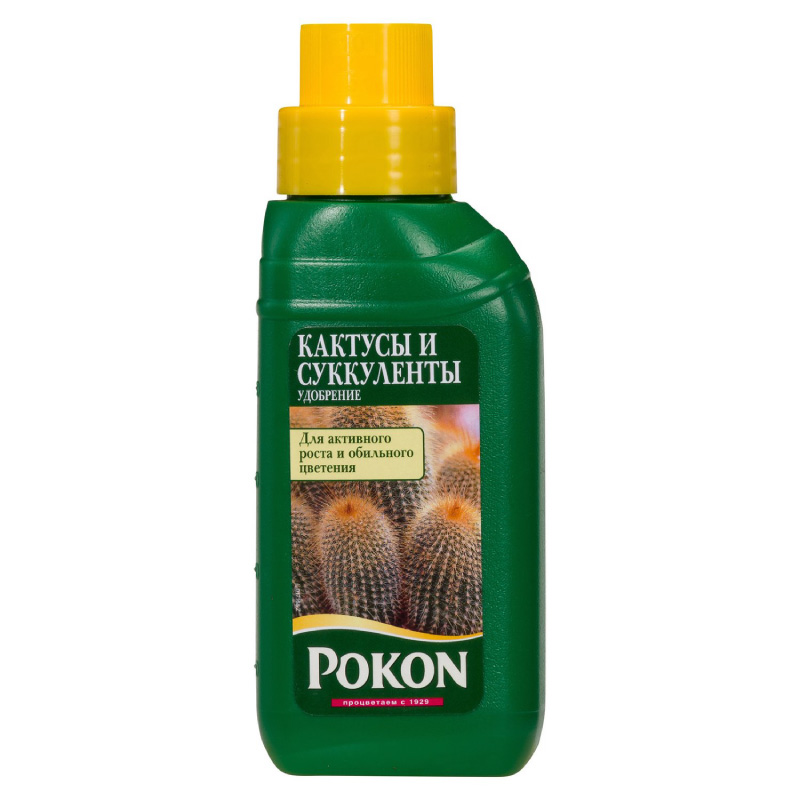
The nitrogen content in the selected fertilizer should be low, otherwise the roots of the Kalanchoe can be damaged. Be sure to feed the plant during the flowering period, you can even weekly, but in small dosages.
How to transplant Kalanchoe
Kalanchoe grows rather quickly, therefore it requires an annual transplant. An adult plant can be transplanted less frequently – every 2 years. This is done, as a rule, in the spring after the end of flowering. The new pot should not be too spacious, sometimes it is enough to update the outer layer of the soil, and the pot can be left as it was..
Choose a soil with a neutral or slightly acidic reaction, pH 5.5-6.5. You can buy ready-made soil for succulents by adding 1/6 of humus to it, or you can mix it yourself. Here are some options:
- 1 part turf soil + 1 part sheet soil + 1 part coarse river sand + ¼ part vermiculite.
- 1 part light loam, 1 part zeolite cat litter, 1 part coconut substrate.
- 1 part coconut substrate, 1 part vermiculite, 2 parts all-purpose soil, 1 part humus.
The transplant process itself is quite simple, here is a step-by-step instruction.
How to transplant Kalanchoe at home
- The soil is slightly moistened, the pot is squeezed or tapped from all sides so that the soil easily moves away from the walls.
- A drainage layer (for example, from expanded clay) is laid out in a new pot. If necessary, additional holes can be made in the bottom of the new pot..
- Gently remove the plant from the previous pot, shaking off the topmost layer of soil, but without damaging the roots.
- Place the plant together with an earthen lump in a new pot and fill the voids with new soil, if possible, without tamping it, but shaking it down – just pat on the sides of the pot so that the earth settles itself.
- Place the transplanted plant in a shaded area and wait 3-4 days with watering.
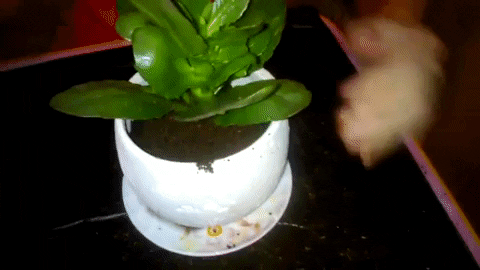
Sometimes, if you need to transplant a blooming Kalanchoe after purchase, then the transshipment method is used. It consists in the fact that the flower is taken out of the store pot and transplanted as it is, without shaking off the soil from it and moving it as carefully as possible with it. In other cases, it is not recommended to transplant flowering Kalanchoe..
For more information about transplanting Kalanchoe at home, see this video.
How to cut Kalanchoe
From time to time, your Kalanchoe needs a haircut. Pruning is carried out after the flowering period – all peduncles are removed from the bush.
Most Kalanchoe species shed old leaf blades, so that these shoots can be cut and planted. The extended stems of the plant are cut in half in the spring, and in the first half of summer, the shoots are pinched.
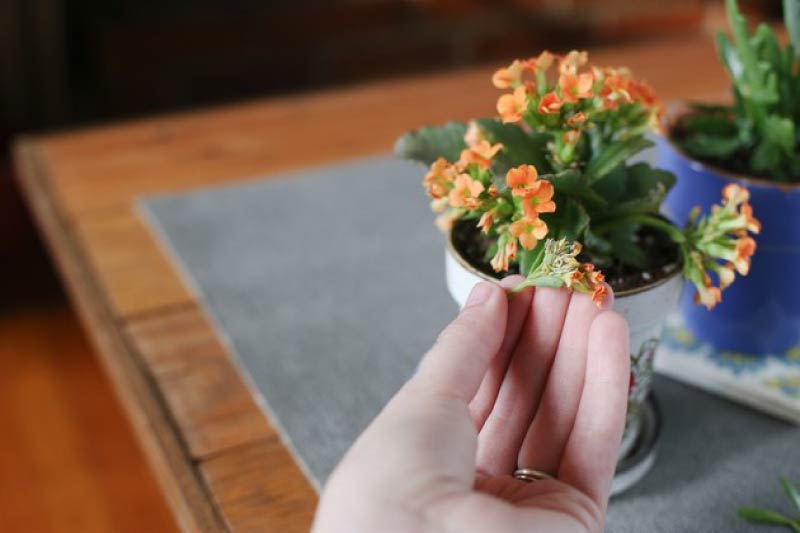
In the photo below you can see what the Kalanchoe will look like if it is not cut off..
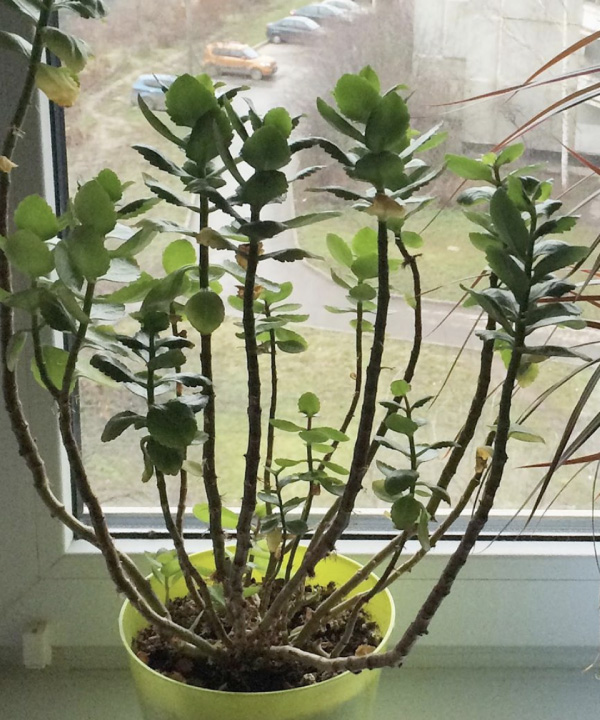
Elongated Kalanchoe without trimming
And here is a useful video about pruning Kalanchoe after flowering.
Reproduction of Kalanchoe
Kalanchoe is propagated by stem and leaf cuttings, children or seeds. The easiest way is to propagate Kalanchoe by cuttings, and we will tell you about it..
- A leaf plate or a piece of shoot can serve as a cutting..
- At the beginning of summer (from March to June), a leaf / shoot is cut off from the parent bush and planted in sand or vermiculite.
- The shoot is covered with a jar and periodically moistened by spraying.
- When roots are formed on the shoot, you can transplant the shoot into a pot..
Experts believe that small shoots and leaves root better in sand, and large ones in water..
Here is a detailed instruction on how to propagate Kalanchoe with a leaf.
The seeds of this plant are very small, so they are simply scattered over the soil surface in January-March and moistened with a spray bottle. The container with soil is covered with glass and paper, aired in the morning and evening. Temperature range – 16-20 ° C. As soon as the shoots appear, the glass and paper can be removed, and after 20-30 days they can be moved to a larger container. When the plants have formed at least three leaf plates, they are settled in individual pots. When they take root, they pinch the top so that the future crown of the Kalanchoe is lush.
If the Kalanchoe sheds its leaves …
Like all indoor plants, Kalanchoe is susceptible to a number of diseases. The reasons can be different.
- For example, in Kalanchoe, the stem stretches out and turns pale, leaves fly around. This is probably a lack of lighting, try moving the pot to a sunnier place..
- If, after active flowering, the plant has frozen in growth and loses its leaves, feeding or transplanting can help.
- Are the Kalanchoe leaves dry? The room air may be too dry. Or you are holding the flower too close to the battery. Or maybe he was attacked by pests.
- It happens that brown soft spots or mold appear on the leaves – this is a sure sign of over-watering, too low temperature and insufficient ventilation..
- If the flower looks quite healthy, but does not bloom, pay attention to the dosage of fertilizers and the percentage of nitrogen in the top dressing – you may have “overfed” the plant.
- Pests to be wary of if you are dealing with Kalanchoe – mealybugs, scale insects, spider mites.












